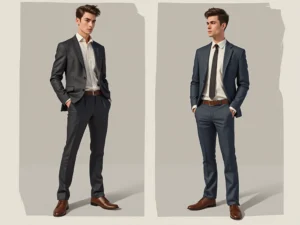
Business Casual vs Business Professional: Striking the Perfect Balance for Success
Business casual vs business professional has always been a common workplace style dilemma. If you’re like me, you’ve probably stood in front of your closet wondering: “Is this too formal? Too relaxed? Am I sending the right message?”
Trust me, you’re not alone. I’ve been there—especially during job interviews, networking events, or even casual Fridays. Navigating the fine line between comfort and credibility can be tricky.
Understanding Business Casual vs Business Professional
Navigating workplace attire can be challenging, but knowing the difference between business casual vs business professional is essential for making the right impression. Whether you’re preparing for an interview, attending an important meeting, or dressing for your daily work environment, choosing the appropriate style demonstrates professionalism and awareness of company culture.
What Is Business Professional?

Business professional represents the most formal end of workplace dress codes. This style is typically required in traditional corporate environments such as law firms, financial institutions, and executive settings.
Key elements include:
- Tailored suits (matching jacket and pants or skirt) in neutral colors like black, navy, or gray
- Crisp, button-down dress shirts with a conservative collar
- Closed-toe dress shoes (oxfords or pumps) in leather or polished materials
- Minimal accessories—think subtle ties, modest jewelry, and professional watches
The goal is to project authority, competence, and attention to detail.
What Is Business Casual?

Business casual offers more flexibility while maintaining a polished appearance. This dress code is common in tech companies, creative agencies, and workplaces with a more relaxed culture.
Key features include:
- Blazers or sport coats (optional, depending on the workplace)
- Dress pants, khakis, or skirts in structured fabrics
- Collared shirts, sweaters, or blouses (avoid overly casual t-shirts)
- Loafers, flats, or clean, minimalist sneakers (if company policy allows)
The focus is on looking put-together without being overly formal. Business casual vs business professional ultimately comes down to context—always observe your workplace norms to strike the right balance.
When to Wear Each Style
Choosing between business casual vs business professional depends on your industry, company culture, and specific occasions. Wearing the appropriate style ensures you make the right impression while staying comfortable in your work environment.
Best Occasions for Business Professional

The business professional dress code is ideal for:
- Job interviews at traditional corporations
- Client meetings in formal industries (law, finance, consulting)
- Important presentations to executives or stakeholders
- Corporate events like galas or award ceremonies
This style conveys authority and attention to detail in high-stakes professional settings.
When Business Casual Is Appropriate

Business casual works best for:
- Everyday office wear in relaxed work environments
- Casual Fridays at companies with formal dress codes
- Internal meetings without external clients
- Creative industries (tech, marketing, design)
This approach maintains professionalism while allowing more personal expression.
Business Casual vs Business Professional: Quick Reference Guide
| Scenario | Recommended Dress Code | Key Items |
|---|---|---|
| Corporate job interview | Business Professional | Suit, dress shirt, leather shoes |
| Client presentation | Business Professional | Blazer, dress pants, polished accessories |
| Casual Friday | Business Casual | Khakis, button-down, loafers |
| Tech startup workplace | Business Casual | Dark jeans, blazer, clean sneakers |
| Board meeting | Business Professional | Matching suit, conservative tie |
Understanding these guidelines helps you navigate business casual vs business professional with confidence. When in doubt, it’s better to be slightly overdressed than underdressed – you can always remove a blazer or tie to adjust your look accordingly.
Remember that company cultures vary, so observe what leaders in your organization wear and check your employee handbook for specific dress code policies. The right attire not only shows respect for your workplace but also boosts your own confidence in professional settings.
Why the Right Dress Code Matters
Business casual vs business professional dress codes goes beyond just clothing choices – it directly impacts your career success and workplace relationships. The way you present yourself communicates professionalism, respect, and attention to detail before you even speak.
First Impressions Count
Studies show people form first impressions within 7 seconds, and your attire plays a major role. Wearing the appropriate business professional or business casual outfit:
- Establishes credibility and competence
- Shows you understand workplace norms
- Demonstrates respect for colleagues and clients
Dress Code Influences Career Growth
Your clothing choices can affect:
- Promotion opportunities (managers notice polished professionals)
- Client relationships (proper attire builds trust)
- Workplace confidence (when you look professional, you feel professional)
Dress Code Guidelines for Different Scenarios
Business Professional Situations
- Corporate interviews
- Board meetings
- Client presentations
- Financial/Legal settings
Key Items:
- Matching suits (navy/black/gray)
- Conservative dress shirts/blouses
- Professional leather footwear
Business Casual Situations
- Casual Fridays
- Internal team meetings
- Creative workplaces
- Tech/startup environments
Key Items:
- Dress pants or dark jeans
- Collared shirts or blouses
- Smart casual footwear
The choice between business casual vs business professional should always consider your specific workplace culture and the occasion. When uncertain, it’s better to err on the side of formality – you can always remove a jacket or tie to adjust your look. Remember that your professional image is an extension of your personal brand, and dressing appropriately shows you take your role seriously.
How to Master Both Styles
Navigating business casual vs business professional dress codes with confidence requires understanding key differences and building a versatile wardrobe. Whether you’re dressing for a corporate meeting or a casual workday, these strategies will help you transition seamlessly between both styles.
Build a Foundation with Core Pieces
For Business Professional:
- Invest in two high-quality suits (navy and charcoal)
- Own 3-5 crisp dress shirts in white and light blue
- Choose polished leather shoes (oxfords or pumps)
- Add conservative accessories (simple tie, minimal jewelry)
For Business Casual:
- Keep well-fitted dress pants in neutral colors
- Stock versatile blazers that pair with multiple outfits
- Own collared shirts and sweaters for layering
- Include smart casual shoes (loafers or clean sneakers)
Learn to Adapt Your Look
Mastering business casual vs business professional means knowing how to modify outfits:
- Dressing Down Professional Attire
-
Remove the suit jacket
-
Swap dress shoes for loafers
-
Loosen or remove the tie
-
- Dressing Up Casual Attire
-
-
Add a structured blazer
-
Tuck in your shirt
-
Upgrade to leather shoes
-
Follow These Pro Tips
- Observe company leaders – notice what managers wear
- Keep spare professional items at work (blazer, dress shoes)
- When in doubt, lean slightly more formal
- Focus on fit – well-tailored clothes always look professional
- Maintain your wardrobe – pressed, clean, and wrinkle-free
By mastering both business casual and business professional styles, you’ll always be prepared for any work situation while maintaining your personal brand. The key is balancing professionalism with comfort, adapting to different environments while always looking put-together.
Business Casual vs Business Professional: The Style Spectrum

Understanding business casual vs business professional isn’t about strict rules, but rather recognizing where your workplace falls on the professional dress spectrum. This guide helps you identify key differences and navigate the gray areas between these two dress codes.
The Professional Dress Spectrum
| Feature | Business Professional | Transitional Style | Business Casual |
|---|---|---|---|
| Jackets/Blazers | Required (matching suit) | Optional (mix-and-match) | Optional |
| Shirts/Tops | Dress shirts with ties | Polished button-downs | Collared shirts or sweaters |
| Bottoms | Dress pants/skirts (suit) | Tailored separates | Khakis or dark jeans |
| Footwear | Leather dress shoes | Loafers or oxfords | Clean sneakers allowed |
| Accessories | Conservative | Minimalist | More personality |
Key Differences in Practice
Business Professional Non-Negotiables
- Always includes a matching suit
- Requires closed-toe dress shoes
- Maintains conservative colors (navy, black, gray)
- Keeps accessories subtle and professional
Business Casual Flexibility
- Allows separates instead of matching suits
- Permits more color and pattern variety
- May include smart casual footwear (in some workplaces)
- Offers more personal expression
Navigating the Gray Areas
Many workplaces operate in the middle of the business casual vs business professional spectrum. For these situations:
- Start with professional foundation (dress shirt, tailored pants)
- Add/remove layers based on formality needs
- Observe what senior staff wears
- When uncertain, ask HR for clarification
The business casual vs business professional spectrum exists to help professionals adapt their appearance to different work environments while maintaining appropriate standards. By understanding where your workplace falls on this spectrum, you can dress confidently for any professional situation.
Avoid These Common Mistakes
Mistake #1: Misreading the Dress Code
- Assuming casual means sloppy – Even in business casual, clothing should be neat and well-fitted
- Overdressing for relaxed environments – Wearing a full suit in a startup may seem out of touch
- Underdressing for formal settings – Jeans at a law firm meeting can damage credibility
Solution: Research company culture beforehand and observe what leaders wear.
Mistake #2: Poor Fit and Maintenance
- Wearing ill-fitting suits or wrinkled shirts – Makes even expensive clothes look cheap
- Choosing uncomfortable shoes – Limits confidence during important meetings
- Neglecting garment care – Stained or faded clothing creates a bad impression
Solution: Invest in tailoring and proper clothing maintenance.
Mistake #3: Inappropriate Footwear Choices
| Dress Code | Wrong Choice | Better Alternative |
|---|---|---|
| Business Professional | Worn-out dress shoes | Polished leather oxfords |
| Business Casual | Flip-flops or gym shoes | Clean leather loafers |
Mistake #4: Going Too Trendy
- Overly bold patterns in conservative fields
- Extreme silhouettes (oversized or skin-tight)
- Casual fabrics like denim in professional settings
Solution: When in doubt, choose classic styles over trends.
Mistake #5: Ignoring Grooming Details
- Unkempt hair or facial hair
- Strong fragrances that may bother colleagues
- Visible tattoos/piercings in conservative environments (unless accepted)
Solution: Match your grooming to your workplace norms.
By avoiding these common errors in business casual vs business professional dressing, you’ll present your best self in any work environment. Remember that your attire should never distract from your skills and professionalism – it should enhance them. When uncertain, it’s always safer to lean slightly more formal than to risk being underdressed.
Why Balance Is the Key to Success
The real magic lies in blending professionalism with personal style. When you find your comfort zone within the workplace’s expectations, it unlocks a new level of confidence.
That’s what striking the balance in business casual vs business professional is all about.
And if you’re still unsure what to wear to your next event or job opportunity, try dressing one step up from what you think is appropriate. It’s always better to look slightly more polished than too casual.
Frequently Asked Questions
1. What’s the main difference between business casual and business professional?
Business professional requires formal suits, dress shirts, and polished leather shoes, while business casual allows more flexibility with blazers, dress pants or dark jeans, and smart-casual footwear.
2. Can I wear jeans in a business casual workplace?
Only if they are dark, well-fitted, and free of distressing. Pair them with a collared shirt and blazer for a polished look. Avoid jeans in conservative industries like finance or law.
3. Are sneakers acceptable in business casual settings?
Some workplaces allow clean, minimalist sneakers in neutral colors. Avoid athletic shoes and opt for sleek leather or canvas styles.
4. Do women have to wear skirts in business professional dress codes?
No. Pantsuits and tailored dresses are equally professional. Focus on structured, conservative silhouettes in neutral colors.
5. How do I know if my workplace is business casual or business professional?
- Check the employee handbook
- Observe what leadership wears
- Ask HR or colleagues for clarification
6. Can I wear short sleeves in a professional setting?
In business professional, avoid short sleeves. In business casual, polo shirts or short-sleeve blouses may be acceptable if neatly tailored.
7. Are ties mandatory for business professional attire?
Typically yes in formal settings (law, finance), but some modern offices allow open collars. When in doubt, wear a tie and remove it if unnecessary.
8. What colors work best for business professional clothing?
Stick to navy, black, gray, and white for a conservative look. Business casual allows more variety but avoid loud patterns in formal settings.
9. Can I wear a blazer with jeans for business casual?
Yes, if the jeans are dark and tailored. Pair them with a crisp button-down shirt and loafers for a smart-casual look.
10. What’s the biggest mistake people make with business casual attire?
Assuming “casual” means sloppy. Even in relaxed dress codes, clothing should be neat, well-fitted, and professional.
Final Thoughts
Mastering the balance between business casual vs business professional attire is about more than just following dress codes—it’s about understanding how your clothing choices impact your professional image. Whether you’re in a formal corporate setting or a more relaxed work environment, dressing appropriately shows respect for your workplace while boosting your confidence. The key is to observe company culture, invest in versatile pieces, and always err on the side of professionalism when uncertain.
Remember that business casual doesn’t mean careless, and business professional doesn’t have to feel restrictive. By building a wardrobe with high-quality basics that can adapt to both styles, you’ll always be prepared to make the right impression. Pay attention to fit, fabric, and grooming details, as these elements often matter just as much as the clothing itself. In the end, successfully navigating business casual vs business professional dress codes means presenting your best self in any professional situation.
You May Also Likes:

